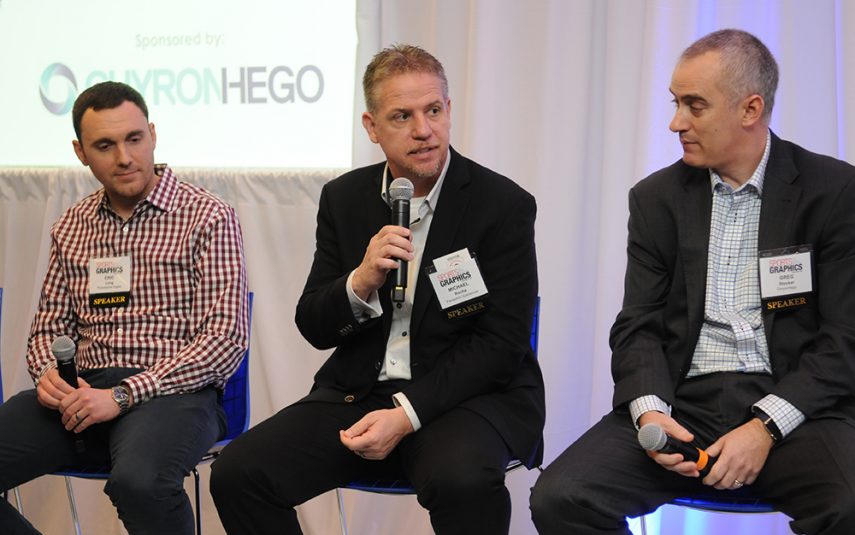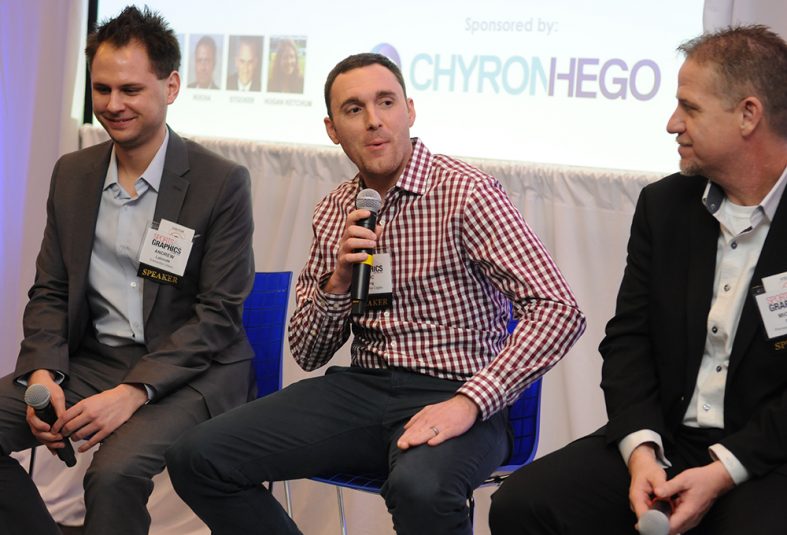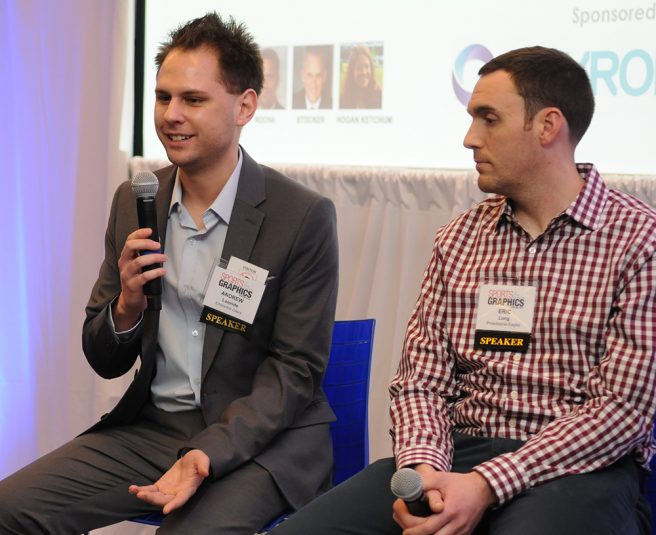Sports Graphics Forum: In-Venue Needs Take Center Stage
Getting vendors involved early helps fulfill a venue’s unique vision
Story Highlights
The graphic needs and philosophies of in-venue–production professionals was the subject of a panel discussion at the SVG 2017 Sports Graphics Forum held in New York City on Wednesday. And one thing was clear: a cookie-cutter philosophy doesn’t work.

From left: Edmonton Oilers Entertainment Group’s Andrew Lalonde, Philadelphia Eagles’ Eric Long, and Panasonic Xperiences’ Michael Rocha
“One of the interesting things about venues is, each is a unique ecosystem with different gear, goals, and canvases,” said Greg Stocker, VP, sports and live events, ChyronHego. “It is important early on to find a vision for what the organization wants to do.”
The United Center in Chicago, for example, uses ChyronHego CG to drive three levels of fascia displays and scoreboards via Crossfire and Blaze.
One challenge is in gauging the size of text fields and other components, according to Stocker: something may look fine on a 16:9 monitor but terrible on a large scoreboard, where people will be sitting 50-400 ft. away.
Andrew Lalonde, digital display specialist, Edmonton Oilers Entertainment Group, provided the perspective of someone in the throes of new construction. At Rogers Palace in Edmonton, AB, which now has the largest videoboard in the NHL, Ross Dashboard plays a key part in distributing content throughout the various displays. “It allows us to have a moment of exclusivity across all of the ribbons and boards with a trigger off one button that is powered by Ross Dashboard,” he noted.
Eric Long, director of production, Philadelphia Eagles, reported that his production team is three seasons removed from the renovation of Lincoln Field and has grown accustomed to working with a canvas that has grown from 9,000 to 23,000 sq. ft.
“We have really funky-shaped boards. Nothing is symmetrical, and that gives us cool opportunities to do things in a different way,” he explained. “Going into the season is learning how to take advantage of the different canvases and make them pop.”
One challenge facing in-venue teams is that they often handle not only the graphics needs for in-venue scoreboards but also TV programs, social platforms, and more. The trick is figuring out how to create basic elements that can work not only on a ribbon board but also on social-media graphics. “They have to be consistent on all platforms,” said Long.

From left: Oilers Entertainment Group’s Andrew Lalonde, Philadelphia Eagles’ Eric Long, and Panasonic Xperiences’ Michael Rocha
Year one, he added, was fast and furious. But now the team knows the technology and adds incremental advances designed to enhance the experience for Eagles fans.
“We understand our room and how it ticks,” he explained. “So now we can have the canvases be cohesive, and, when a touchdown is scored, we can envelop the whole stadium. And then,” he added, “there are specific situations that can be treated in a nuanced way.”
For example, this year, on the out-of-town scoreboard, the team added a red box around the teams that are in the red zone. “It’s like watching ESPN’s bottom line,” he pointed out.
Long said the production team also works closely with the team PR staff, alerting them to milestones that might occur during the games.
Another challenge with in-venue graphics is to provide fans all the information they need, allowing them to focus more easily on the game rather than attempting to find it on their phone. That includes plenty of statistics, background information, and replays.
The in-venue production team can’t get to a high level of capability all by themselves. When a new system is being installed, the integrators and the technology providers are important partners in making sure the team can hit the ground running.
Michael Rocha, director, creative/technical solutions, Panasonic Xperiences, said his team prefers to be brought in as early as possible to create a “mood deck” for the videoboard, establishing the attitude that will be projected through it. Once the attitude is agreed on, pre-visualizations can be created so that the team owner can get a sense of what the experience will be like.
“Once the season starts, there is no time to change things,” he pointed out. “The earlier you can have a plan and stick to it, the better.” The goal is to get to the point where a user can pull a font and color and quickly throw together a graphic requested 20 minutes before the game.
Automation also plays a part in improving the content-creation workflow.
“If someone works 90% of their time on one project and then 10% on another,” said Rocha, “you are best off taking that 10% and automating it or moving it to another person on staff.”
Real-time rendering is also becoming more important with the growing need to handle the real-time data that can be the backbone of dynamic content.
“You want to present a show in layers,” he suggested. “You have to have stats available for the person who wants everything and then for the kids that want to just have a good time.”
One thing is certain when it comes to venue-graphics operations: change is a constant, and productions will continue to become more robust.
“Productions today are matching Olympic-level productions from 15 years ago,” said Stocker. “And the team is triggering different types of delivery systems, so there are times when the production switcher will trigger the CG and replays. Interoperability of control-room technology has changed everything.”

